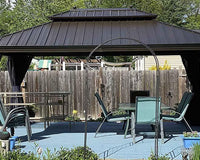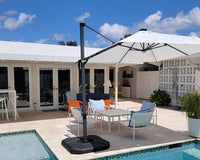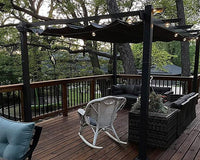A classic representation of comfort, leisure, and personal taste, porch swings These adaptable seating choices have been encouraging people to relax for years, whether they are hung from a strong tree branch, tucked in a garden retreat, or set on a lovely front porch. Selecting the ideal porch swing goes beyond appearances; it's about building a personal haven that captures your way of life, withstands environmental challenges, and offers years of delight. This thorough guide will show you every important factor, thereby enabling you to turn your outside area into a refuge of peace and comfort.
1. Set the Foundation for Your Perfect Porch Swing
Assess Your Space
Measurement is critical when selecting a porch swing. Carefully measure your available space, ensuring 14-18 inches of clearance on each side. Your mounting surface must safely support 500−750 pounds, requiring sturdy wooden beams or reinforced attachment points.
Installation Options
- Traditional porch mounting
- Freestanding metal frames
- Tree installations
- Deck attachments
Key Spatial Guidelines:
- Swing arc space: 3-4 feet
- Seat height: 18-22 inches
- Overhead clearance: 7 feet minimum
Lifestyle and Usage Factors
Swing selection depends on your specific needs and usage patterns. Consider the following factors:
User Capacity:
- Single user: 36-48 inch swing
- Couples/small groups: 48-60 inch swing
- Family/entertainment: 60-72 inch swing
Purpose Considerations:
- Relaxation: Cushioned, ergonomic designs
- Reading: Deeper seats with side tables
- Entertainment: Wider, sturdier models
Climate and Durability:
- Humid regions: Rust-resistant materials
- Coastal areas: Marine-grade components
- Dry climates: UV-resistant fabrics
- Cold regions: Winterizable designs
Practical Selection Tips:
- Match material to local weather conditions
- Consider frequency of use
- Invest in weather-resistant cushions
- Plan for seasonal maintenance
The right porch swing transforms an outdoor space into a personal retreat, blending functionality, comfort, and individual style.
Select the Ideal Porch Swing Material

| Material | Durability | Weather Resistance | Maintenance | Cost | Longevity |
| HDPE | High | Excellent | Low | Moderate | 15-20 years |
| Aluminum | Very High | Excellent | Very Low | Moderate | 20+ years |
| Teak | High | Excellent | Moderate | High | 25+ years |
| Steel | High | Good | Moderate | Low | 15-20 years |
| Wrought Iron | High | Good | High | Moderate | 15-20 years |
| All-Weather Wicker | Moderate | Good | Moderate | Moderate | 10-15 years |
| Softwoods | Low | Poor | High | Low | 5-10 years |
High-Density Polyethylene (HDPE)
HDPE offers exceptional weather resistance and minimal maintenance. Synthetic and lightweight, it resists fading, cracking, and moisture damage. Ideal for modern, low-maintenance outdoor spaces.
Aluminum and Steel
Metal swings provide durability and sleek design. Aluminum is rust-resistant and lightweight, while steel offers strength at a lower cost. Both require minimal maintenance and withstand various weather conditions.
Hardwoods
Teak, oak, and acacia represent premium wood choices. These materials offer natural beauty, exceptional durability, and inherent weather resistance. Teak stands out as the most prestigious option, naturally repelling moisture and insects.
Wrought Iron
Classic and robust, wrought iron swings provide timeless aesthetic and structural integrity. They require regular maintenance to prevent rust but offer unmatched strength and traditional charm.
All-Weather Wicker
Modern synthetic wicker combines traditional appearance with contemporary performance. Resistant to UV rays and moisture, it provides a lightweight, stylish option for contemporary outdoor settings.
Softwoods
While affordable, softwoods like pine offer limited durability. They require frequent maintenance and are most suitable for covered, protected areas with minimal weather exposure.
Recommended Selection Strategy
- Consider local climate
- Evaluate maintenance capabilities
- Balance budget with long-term durability
- Prioritize personal aesthetic preferences
Explore Swing Styles and Design Considerations
Swing Types
Traditional Porch Swings
Classic wooden designs featuring horizontal slat construction, these swings embody timeless American charm. Typically two-seater models with simple, functional aesthetics that complement most architectural styles.
Bed Swings
Larger, more luxurious options resembling suspended beds. Perfect for creating a dramatic outdoor relaxation space. Often featuring plush cushions and wider dimensions, ideal for afternoon napping or lounging.
Adirondack-Style Swings
Characterized by wide, angled backs and deep seats. These swings combine comfort with rustic outdoor design, offering superior ergonomic support and a distinctive architectural silhouette.
Modern Minimalist Designs
Sleek and clean-lined swings featuring geometric shapes and contemporary materials. Typically constructed from metal or high-performance synthetics, these designs appeal to minimalist aesthetic preferences.

Design Elements to Consider
Seat Dimensions
Optimal seat depth ranges from 18-24 inches, with width varying between 36-72 inches. Consider user comfort and intended number of occupants when selecting dimensions.
Ergonomic Considerations
Look for:
- Slight backward seat angle
- Supportive back design
- Rounded edges
- Appropriate weight distribution
Aesthetic Compatibility
Select a swing that complements your:
- Home's architectural style
- Outdoor decor
- Personal design preferences
Customization Options
Many manufacturers offer:
- Color variations
- Material choices
- Cushion selections
- Optional accessories
4. Understand Technical Specifications for Swing Selection
Swing dimensions directly impact functionality and comfort. Compact 36-48 inch models suit individual users or small spaces, while 48-60 inch swings accommodate two to three people. Larger 60-72 inch designs serve family gatherings and expansive areas. Standard swings safely support 350−500 pounds, with commercial models handling up to 750 pounds.
Suspension systems determine swing stability and performance. Galvanized steel chains provide durability and traditional aesthetics, resisting corrosion and supporting substantial weight. Marine-grade synthetic ropes offer flexibility and weather resistance.
Mounting requires high-quality stainless steel components with a minimum tensile strength of 1000 pounds. Ideal hardware features corrosion resistance, smooth rotation, and precision-engineered connections. Installation techniques vary by mounting surface—wooden beams need robust lag bolts, while concrete demands specialized anchoring.
Vertical clearance should range from 6-8 feet, ensuring comfortable swing motion. Professional installation is recommended for complex mounting scenarios, with regular inspections of suspension components to maintain safety and longevity.
5. Enhance Swing Comfort and Functionality

Use strategic accessory choice to improve your porch swing experience. Premium outdoor cushions with their water-resistant fabrics and ergonomic contouring turn simple seats into opulent relaxation areas. While integrated cup holders offer easy drink placement, decorative throw cushions add color and lumbar support.
Protective covers shield against environmental damage and enhance swing longevity. Superior protection comes from waterproof materials like marine-grade polyester and solution-dyed acrylic. Options for integrated LED lighting produce ambient evening settings; flexible illumination comes from solar-powered and battery-operated solutions.
Ergonomic design centers on important comfort levels. To assist natural spine alignment, ideal seat depth varies from 18 to 22 inches and includes a small backward angle of 15 to 20 degrees. 2-3 inch thick, high-density foam cushions offer perfect pressure distribution.
Material softness ratings prioritize:
- Breathable fabrics
- Quick-drying properties
- UV resistance
- Hypoallergenic compositions
Recommended padding materials include:
- Marine-grade polyester
- Sunbrella performance fabrics
- Closed-cell foam cores
- Moisture-wicking textiles
Strategic accessory selection transforms functional seating into personalized comfort zones, enhancing outdoor relaxation experiences.
6. Evaluate Budget for Strategic Swing Investment
From 150 to 350 dollars, entry-level swings provide basic functions with a limited lifespan. These $350–$750 mid-range choices offer higher materials, enhanced quality, and stronger structural integrity.
Premium investments of more than 750 dollars reflect high-end workmanship with better materials like marine-grade teak, cutting-edge engineering, and elegant design features. These swings provide extraordinary lifetime and artistic refinement.
Long-term cost analysis calls for thorough evaluation going beyond first purchase cost. Imagine:
- Maintenance Expenses
- Annual maintenance costs
- Material-specific care requirements
- Potential repair interventions
- Durability Factors
Projected lifespan influences true economic value:
- HDPE/Aluminum: 15-20 years
- Hardwood: 20-25 years
- Softwood: 5-10 years
- Calculation Strategy: TotalCost = Purchase Price + (Annual Maintenance × Projected Lifespan)
Your Ideal Porch Swing Is Here Waiting
Choosing the perfect porch swing is a personal trip of juggling comfort, utility, and design. Careful consideration of space, materials, design, and budget will help you to create a beloved leisure area from an average outdoor space. Recall that the ideal swing invites you to calm down, relax, and create lifelong memories—more than just furniture. Your perfect porch swing is just ready to be the center of your outdoor living area, whether your taste is for classic hardwood appeal or modern minimalist design.




